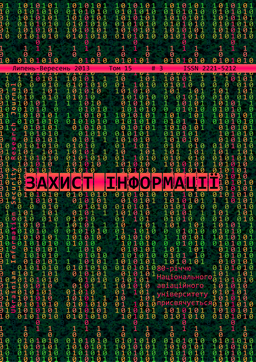The method of permutations generating for an arbitrary quantity of elements
DOI:
https://doi.org/10.18372/2410-7840.15.4864Keywords:
permutation, pseudorandom permutation, base set, quantity of elements, complexity of implementation, statistical characteristicsAbstract
Every ciphering algorithm is based on two operations: substitution and permutation. So it is required to have a reliable permutations generator to construct a crypto- graphically strong cipher. The modern ciphers perform permutations only inside one separate block but not for the blocks among the whole message and this does not allow increasing the strength. Moreover the existing methods of permutations generating either do not allow generating a single pseudorandom permutation or having restrictions on the quantity of elements of the base set or do not provide the pseudorandom format of the permutations and they are difficult in the point of view of implementation. The developed method provides generating of a single pseudorandom permutation of an arbitrary quantity of elements and it is quite easy in implementation due to absence of complex computations. The method has eight variants which differ with the statistical characteristics of pseudorandomnicity evaluation. The algorithm of permutations generating, the mathematical model and the evaluation of comparison between the developed and existing methods are shown in this article.References
Шеннон К. Работы по теории информации и кибернетике. — М.: Изд. иностр. лит, 1963. — 830 с.
Шнайер Б. Прикладная криптография. — М.: Триумф, 2002 - 816 с.
Ковалевский В. Криптографические методы. — М.: "Компьютер Пресс", 1993-236 с.
Баричев С. Г, Гончаров В. В. Стандарт AES. Алгоритм Rijndael. — М.: "Горячая линия — Телеком", 2002-с. 30-35.
Липский В. Комбинаторика для программистов. -М.: "Мир", 1988-200 с.
Виленкин И. Я. Индукция. Комбинаторика. — М.: "Просвещение", 1976 - 48 с.
Кнут Д.- Искусство программирования. Часть 2. — М.: "Мир", 1976-788 с.
Орлов А. И. Прикладная статистика. Учебник. / А. И. Орлов. — М.: Издательство «Экзамен», 2004 - 656 с.
Shannon, С. (1963) Works About Information Theory and Cybernetics. Moscow: Foreign Literature Edition.
Schneier, B. (2002) Applied Cryptography. Moscow: Triumph.
Kovalevskiy, V. (1993) Cryptographic methods. Moscow: Compuer-Press.
Barichev, S. (2002) AES Standard. Rijndael Algorithm. Moscow: Hot Line — Telecom.
Lipskiy, V. (1988) Combinatory for Programmers. Moscow: Mir.
Vilenkin, N. (1976) Induction. Combinatory. Moscow: Prosveshchenie.
Knuth, D. (1976) The Art of Computer Programming. Part 2. Moscow: Mir.
Orlov, A. (2004) Applied statistics. Moscow: Ekzamen.
Downloads
Issue
Section
License
Authors who publish with this journal agree to the following terms:- Authors retain copyright and grant the journal right of first publication with the work simultaneously licensed under a Creative Commons Attribution License that allows others to share the work with an acknowledgement of the work's authorship and initial publication in this journal.
- Authors are able to enter into separate, additional contractual arrangements for the non-exclusive distribution of the journal's published version of the work (e.g., post it to an institutional repository or publish it in a book), with an acknowledgement of its initial publication in this journal.
- Authors are permitted and encouraged to post their work online (e.g., in institutional repositories or on their website) prior to and during the submission process, as it can lead to productive exchanges, as well as earlier and greater citation of published work (See The Effect of Open Access).

